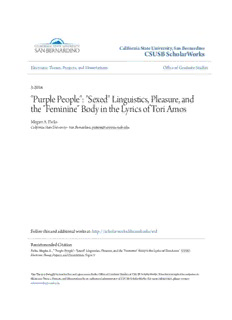
Linguistics, Pleasure, and the "Feminine" Body in the Lyrics of Tori Amos PDF
Preview Linguistics, Pleasure, and the "Feminine" Body in the Lyrics of Tori Amos
CCaalliiffoorrnniiaa SSttaattee UUnniivveerrssiittyy,, SSaann BBeerrnnaarrddiinnoo CCSSUUSSBB SScchhoollaarrWWoorrkkss Electronic Theses, Projects, and Dissertations Office of Graduate Studies 3-2014 ""PPuurrppllee PPeeooppllee"":: ""SSeexxeedd"" LLiinngguuiissttiiccss,, PPlleeaassuurree,, aanndd tthhee ""FFeemmiinniinnee"" BBooddyy iinn tthhee LLyyrriiccss ooff TToorrii AAmmooss Megim A. Parks California State University - San Bernardino Follow this and additional works at: https://scholarworks.lib.csusb.edu/etd Part of the Lesbian, Gay, Bisexual, and Transgender Studies Commons, Other Feminist, Gender, and Sexuality Studies Commons, and the Women's Studies Commons RReeccoommmmeennddeedd CCiittaattiioonn Parks, Megim A., ""Purple People": "Sexed" Linguistics, Pleasure, and the "Feminine" Body in the Lyrics of Tori Amos" (2014). Electronic Theses, Projects, and Dissertations. 5. https://scholarworks.lib.csusb.edu/etd/5 This Thesis is brought to you for free and open access by the Office of Graduate Studies at CSUSB ScholarWorks. It has been accepted for inclusion in Electronic Theses, Projects, and Dissertations by an authorized administrator of CSUSB ScholarWorks. For more information, please contact [email protected]. “PURPLE PEOPLE”: “SEXED” LINGUISTICS, PLEASURE, AND THE “FEMININE” BODY IN THE LYRICS OF TORI AMOS ______________________ A Thesis Presented to the Faculty of California State University, San Bernardino ______________________ In Partial Fulfillment of the Requirements for the Degree Master of Arts in English Composition ______________________ by Megim Alexi Parks March 2014 “PURPLE PEOPLE”: “SEXED” LINGUISTICS, PLEASURE, AND THE “FEMININE” BODY IN THE LYRICS OF TORI AMOS ______________________ A Thesis Presented to the Faculty of California State University, San Bernardino ______________________ by Megim Alexi Parks March 2014 ______________________ Approved by: Dr. Jacqueline Rhodes, Committee Chair, English Dr. Caroline Vickers, Committee Member Dr. Mary Boland, Graduate Coordinator © 2014 Megim Alexi Parks ABSTRACT The notion of a “feminine” style has been staunchly resisted by third-wave feminists who argue that to posit a “feminine” style is essentialist. Yet, linguists such as Norma Mendoza-Denton and Elinor Ochs discuss indexicality and shifting through salient variables, a process called entextualization. Further, French feminists such as Hélène Cixous and Julia Kristeva use the linguistic concept of intertextuality to explain certain poetic uses of language that might cause what Luce Irigaray calls “irruption of the semiotic chora”—moments within language where boundaries in the semiotic chain of signification are “blurred.” Thus, while current feminism has moved strictly away from the idea that there is an exigent “feminine” to which all women must aspire, there exists a tenuous, but salient connection between the linguistic concepts of indexicality and intertextuality on one hand, and jouissance and “irruption of the chora” on the other that can inform those styles we might term “feminine” and allow for a more productive and responsive perception of “femininity.” Amos’ lyrics illustrate these theories working together; Amos’ lyrics represent such a “feminine” style as indexed through use of salient variables; thus, Amos’ lyrics represent a sociolinguistic phenomenon wherein gender-based salient variables reform what “feminine” is and means, challenging social attitudes and the specular feminine persona within both the personal and public spheres. The implications of these theories could eventually influence iii perceptions of women in any particular profession or sphere, as gendered linguistic markers influence gender roles and implications, which, in turn, inform social change. iv ACKNOWLEDGEMENTS I want to thank my graduate coordinator, Dr. Mary Boland, for her constant reassurance that I have the academic prowess necessary to complete this project. I wish also to thank my thesis readers, Dr. Jacqueline Rhodes and Dr. Caroline Vickers, for their help in completing this thesis. This work has been painstaking and exhausting at some points, and I appreciate your support and revisions. I want to also thank the department Chair, Dr. Sunny Hyon, and many of my classmates and students who have supported me in my continuance of my studies. I would be remiss if I did not thank my family and friends, especially Caid and Ian Parks, Ryan Parks, Jennifer Parks, Ben Parks, and Barry Harvey, and Ron Parks and Dee Parks, and also my parents, Andrea and Dean Fisher, for their love and support and for their belief in my academic ability and their support of my spending such exhausting hours in completing this project. I would also like to thank a few of my co-workers for their support in completing this project, namely, Anna Slavick-Lewis and Rob Hellebrand. For their encouragement I am grateful. I owe a debt of gratitude to Tori Amos for her songwriting, not to mention for the ways she has helped me revision the “feminine” and to revision myself in relationship to that ideology; and to the mainstays of my theoretical approach I have a profound respect, namely, Julia Kristeva, Luce Irigaray, Judith Butler, Norma Mendoza-Denton, Elinor Ochs, Penelope Eckert, and Roland Barthes. v TABLE OF CONTENTS ABSTRACT .......................................................................................................... iii ACKNOWLEDGEMENTS ..................................................................................... v CHAPTER ONE: THEORY ................................................................................... 1 An Overview of the Specular and Textual Pleasure ................................... 2 Foreground: Identity Through Stylistic Moves ............................................ 4 Revisioning an Old Saw: Finding Peace Between Disparate Theoretical Approaches ........................................................... 10 The Nonthematizable, Pleasurable Other ................................................ 13 Barthes: Pleasure, Intertextuality, and Desire .......................................... 18 Do Purple Bodies Matter?: Bodies By Butler ........................................... 21 A Final Note: Feminine Identity Styling/Performance ............................... 25 Musical Artists in General and Amos in Particular ................................... 26 Case In Point ........................................................................................... 28 CHAPTER TWO: EXPLICATION Stage One--Mother, Shame, and the Wound ........................................... 31 “Mother” and Barthes ............................................................................... 33 Stage Two: Sexual Rage and Irruption of the Chora ............................... 47 Stage Three: Change/Jouissance ............................................................ 53 vi CHAPTER THREE: BUTLER, THE SACRED AND THE DISIDENTIFICATION OF NAMING ............................ 60 Foreground .............................................................................................. 62 Butler and the “Tacit Cruelties” of the Bound Thetic ................................ 64 The Sacred Act of Naming ....................................................................... 68 The Performative Power of the Name ...................................................... 74 Agency and Performative Power ............................................................. 83 Reopening Terms: “Women” and “Queer” ............................................... 85 The Forming of a (Logical) Subject .......................................................... 87 Afterword ................................................................................................. 91 WORKS CITED .................................................................................................. 93 vii
Description: